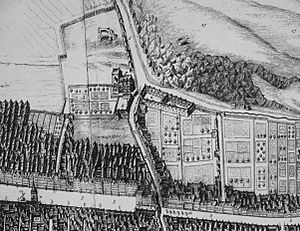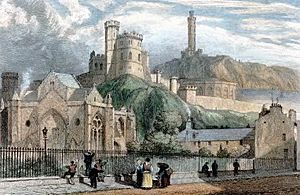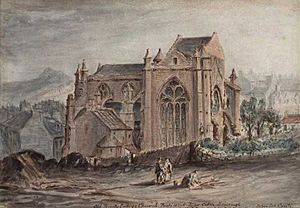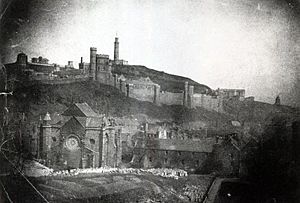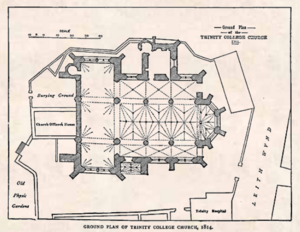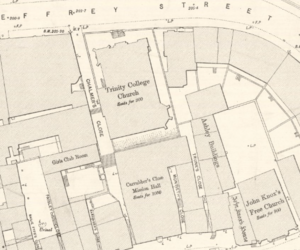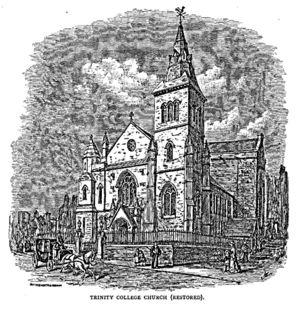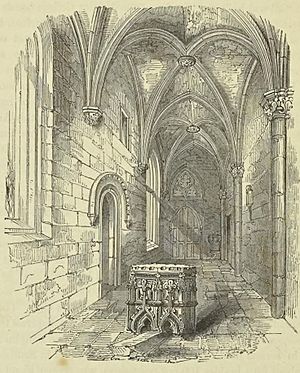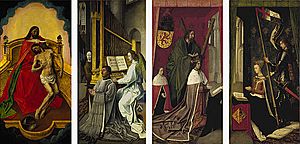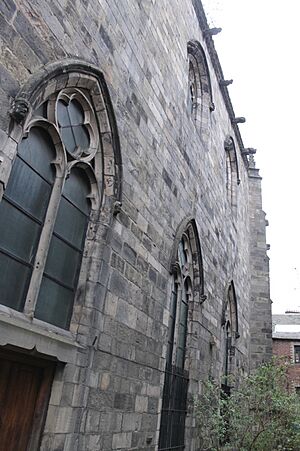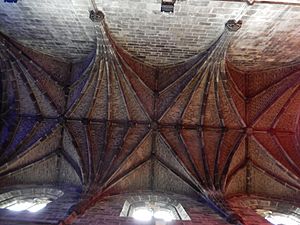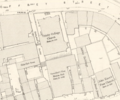Trinity College Kirk facts for kids
Trinity College Kirk was an important collegiate church in Edinburgh, Scotland. A collegiate church is a special type of church that has a group of priests, called a "college," who live together and perform religious services.
The church and a nearby home for the poor, called Trinity Hospital, were started in 1460. They were founded by Mary of Guelders, who was the Queen of Scotland at the time. She built them to remember her husband, King James II, who had died that year. Queen Mary was buried in the church, but her coffin was later moved to Holyrood Abbey in 1848.
The church was never fully finished as planned. Only parts like the apse (a rounded end of the church), the choir (where the singers sit), and the transepts (the parts that stick out on the sides) were built.
The church was located in a valley between Edinburgh's Old Town and Calton Hill. In 1848, it was carefully taken apart because Waverley Station was going to be built on its site. The stones were numbered so they could be put back together later. They were stored on Calton Hill. However, by 1872, when a new church was finally built on Jeffrey Street, only about a third of the original stones were left. These remaining stones were used to build a part of the new church, which became its hall.
Contents
Church Design and Look
The church was built using local sandstone, which came from a quarry not far away. It was designed in a popular style of the time called Scottish late Gothic. This style often features tall arches, pointed windows, and detailed carvings.
One interesting feature was the gargoyles, which are carved stone figures that stick out from the roof. They were used to drain water away from the building. It's also said that the church had several monkey carvings as part of its decorations, which was quite unusual!
How the College Started
Trinity College included the Trinity College Church, Trinity Hospital, and homes for the priests. The college was set up for a leader called a provost, eight priests (called prebendaries), and two clerks. Each of them was given land or income to support themselves. The money came from different places in Scotland, either given by Queen Mary of Guelders or added later. For example, they received money from a place for people with leprosy in Fife and from a church in Easter Wemyss.
Later, more leaders were added, and more income sources were included from other parishes (church areas) around Scotland.
Early Years of the Church
The church and hospital of Soutra Aisle were linked to Trinity College. In 1460, Queen Mary of Guelders received permission from the Pope to connect Soutra to her new Trinity College. This meant the provost of Trinity College would also be in charge of Soutra church and had to support three poor people at Soutra hospital.
In 1463, Pope Pius II announced that people who visited the church during the feast of the Holy Trinity (July 10th) and the following eight days could receive a special blessing if they donated money to help finish the church building. The money was kept in a locked box, and a third of it went to the Catholic church.
The church was famous for its beautiful painting called the Trinity Altarpiece. This large painting, created around 1479 by Hugo van der Goes, is now displayed in the National Gallery of Scotland. It shows King James III, his wife Margaret of Denmark, and their son, the future King James IV. It also features Edward Bonkil, the first provost of Trinity College, who helped pay for the painting.
Records about the church's early construction are missing. In 1531, the provost, Master John Dingwall, hired a mason named Robert Dennis to work on completing the church. King James V even asked the Pope for permission for Dingwall to offer special blessings to visitors who donated to the building work. However, after Dingwall died in 1533, the church was still not finished. Only the apse, choir, and transepts were ever completed.
After the Scottish Reformation in 1560, the church building was no longer controlled by the religious leaders but by the Crown (the government). In 1567, the church and hospital property were given to the city of Edinburgh to be used as a hospital for the poor and sick. Building materials for changes were brought from a nearby demolished monastery.
For a while, the church served the hospital. Then, in 1584, it became the official church for the northeast part of Edinburgh until it closed.
From 1813 to 1833, the minister of Trinity College was Rev. Walter Tait. He was later removed from his position in 1833 because he allowed unusual events during church services. He then became a pastor at another church until he died in 1841.
Taking Down and Rebuilding the Church
In 1844, a railway company received permission to buy land for its new railway station, Waverley Station. This meant the Trinity College Kirk and its hospital, along with other buildings, had to be taken down.
The law required the railway company to rebuild the church exactly as it was, or pay the city council enough money to rebuild it.
The old church was taken down in 1848, even though many people protested. Before it was demolished, photographers David Octavius Hill and Robert Adamson took pictures of it.
To prepare for rebuilding, the church's stones were numbered and stored on Calton Hill. The railway company chose to pay the city council £18,000, which was the estimated cost to rebuild the church.
However, due to legal problems, nothing was done for almost 30 years. During this time, many of the stored stones were stolen.
Most of the church's members had left to join a different church group. The remaining members, about 80 people, used temporary places for worship for many years.
The chosen spot for the new church was on a newly created street called Jeffrey Street. The church was the first building constructed there.
The new church opened in October 1877 and could hold up to 900 people. The old stone font from the original medieval church was placed in the new building.
The front part of the new church on Jeffrey Street was completely new and designed by John Lessels. The remaining original stones (about one-third) were used to build a part of the old church's choir and apse at the back of the new building. This section was called the Trinity Apse and served as the church hall. In the 1960s, Lessels' new church was taken down to make way for an office building, leaving the Trinity Apse standing alone. That office building has since been turned into a hotel.
In the 1980s, the Trinity Apse was home to the Edinburgh Brass Rubbing Centre, where visitors could make rubbings of historical brass plaques.
Today, the rebuilt Apse, along with some carved stone pieces and its boundary wall, is a protected historic building. Some statues and stone decorations from the church are now in the gardens of Craigcrook Castle in west Edinburgh.
Important People Connected to the Church
Many important religious leaders were connected to Trinity College Kirk over the centuries. These included provosts, who were the main leaders of the college, and ministers, who led the church services. Some of these individuals became very well-known in Scotland's religious history.
Notable Burials
Several important people were buried in the floor of the original church:
- Mary of Guelders (1463), the queen who founded the church. Her body was later moved to Holyrood Abbey.
- Bishop Thomas Spens (died 1480).
- Lady Sophia Ruthven (1592), the first wife of a duke.
- Lady Jane Hamilton (1596), the first wife of an earl.
Images for kids


